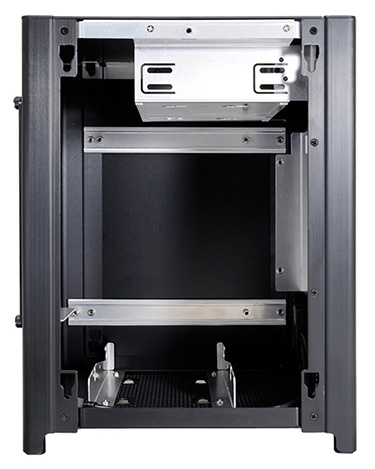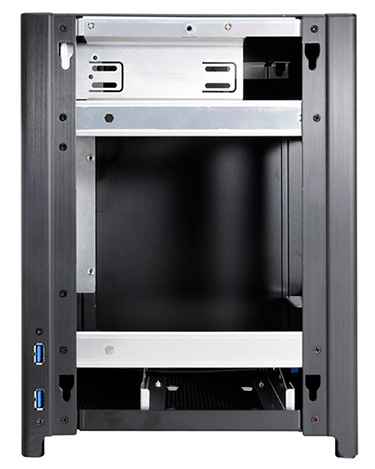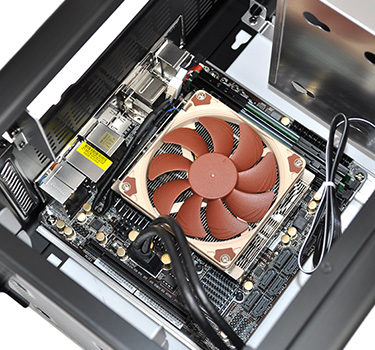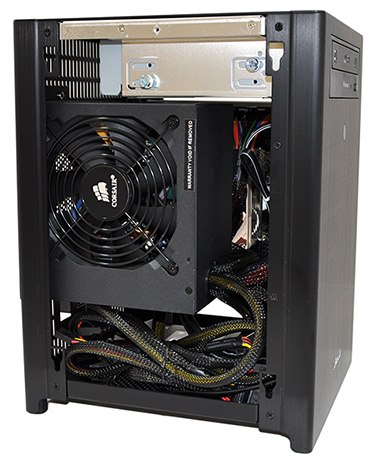Inside The PC-Q27
Lian Li's latest mini-tower enclosure certainly has enough room to house a powerful mini-ITX build, yet the PC-Q27 isn't as forward-looking as it might have been. At the top of the device, the 5.25in drive bay occupies a good amount of space and, when used, will ultimately spoil the chassis' clean aesthetic.
In response to the industry's move to all things digital, we'd really like to see a version of the PC-Q27 without an optical bay. The resulting chassis would be more compact, more elegant and, with less aluminium used, presumably cheaper, as well. And take our word for it, if you do plan on installing a DVD/Blu-ray drive, make sure it's quiet; the vibration caused by a cheap drive can be maddening on a table-top PC.
At the heart of the chassis, two rails are used to plant your mini-ITX motherboard of choice. Our new small-form-factor test platform consists of an ASRock FM2A85X-ITX board, an AMD A10-6700 APU, 16GB of Adata XPG DDR3 memory and a low-profile Noctua NH-L9a cooler. The makings of a well-rounded, compact rig, we reckon.
The HEXUS team is accustomed to using cavernous chassis such as the Corsair 900D, but the fact that we found the PC-Q27 easy to build into is testament to Lian Li's build quality and well-laid-out design. There are no case-fan cables to contend with, the front USB 3.0 ports connect via an on-board header, and users of older motherboards will appreciate the fact that a USB 3.0-to-2.0 adapter is included in the box.
The trio of storage bays, meanwhile, should be plentiful for most users, though the use of certain bays does come at the expense of other mounting options. At the top of the chassis, the 5.25in bay can be used to mount a 3.5in hard disk (though of course doing so will cancel out the ability to install an optical drive), and at the bottom of the chassis there's a mount for either a 2.5/3.5in drive. This bottom area is also the PC-Q27's one-and-only fan-mount location, with support for either a 120mm or 140mm spinner. Choose to install a storage device here and you'll lose those extra fan privileges.
Given these trade-offs, we suspect it's the third drive mount that most users will utilise for their system disk. Mounted on the inner side of the chassis' front face, it supports a single 2.5/3.5in disk which is installed using the bundled anti-vibration rubber rings.
You could, if you really wanted to, equip the PC-Q27 with two SSDs in a high-speed RAID configuration, backed up with a high-capacity 3.5in drive for excess storage. It's unfortunate, however, that a similar level of flexibility hasn't been applied to the expansion slots and, by association, dedicated graphics. The single available expansion slot is arguably the chassis' greatest weakness, as it all-but rules out the use of high-performance cards. A shame, really, as the PC-Q27 could house a graphics card measuring up to 195mm in length. Reiterating an earlier point, we'd gladly lose the optical bay in favour of an extra expansion slot.
Available space and cable clutter aren't a problem... until you install a power supply. The standard ATX mount is positioned above the motherboard tray (limiting CPU cooler height to just 70mm) and a removable mounting bracket is used to help ease installation; it allows you to attach all cables first and then slide in the PSU from the outside.
Power supplies measuring up to 180mm are supported, and our Corsair CX430 fits in easily enough. There's plenty of room to store excess cables - particularly if you choose not to use the expansion slot - though those wanting to maintain a tidier build would be better served by a modular PSU or a space-saving SFX unit.














